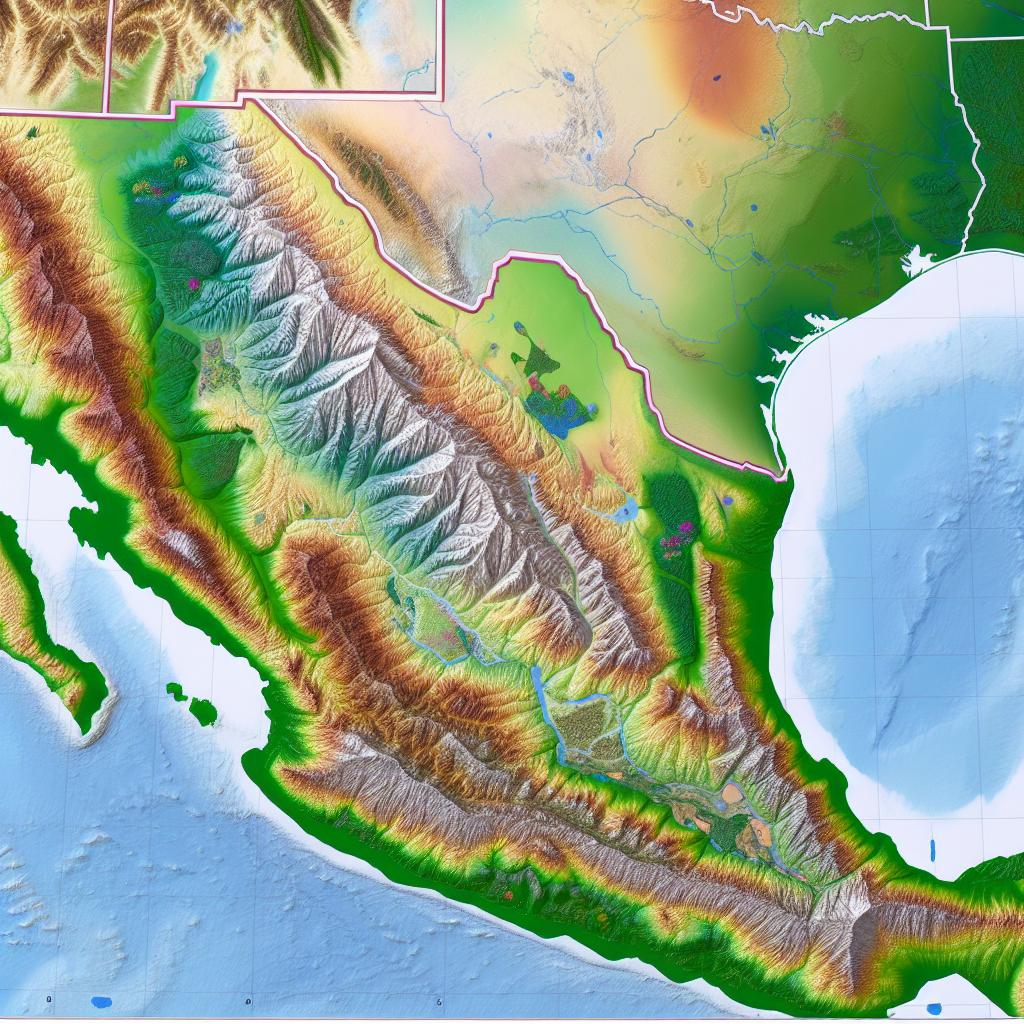Geographic Landscape of Mexico
Mexico, officially known as the United Mexican States, is situated in the southern part of North America. Bordered by the United States to the north, the Pacific Ocean to the south and west, Guatemala and Belize to the southeast, and the Gulf of Mexico to the east, Mexico covers an area of approximately 1.96 million square kilometers (about 758,449 square miles).
Geological Features
Mexico is renowned for its diverse terrain. The Sierra Madre ranges, which include the Sierra Madre Occidental, Sierra Madre Oriental, and Sierra Madre del Sur, dominate much of the country. These mountain ranges are integral to the national geography and are vital in influencing weather patterns and habitat distribution across the regions. Additionally, the Mexican Plateau lies between these ranges, hosting the country’s significant urban and agricultural regions. This plateau is a crucial area where the most intensive farming takes place, providing a substantial portion of the nation’s food production. The geographical diversity inherent in these mountain ranges and the plateau contributes to varied ecosystems that are home to numerous species of plants and animals.
To explore more about Mexico’s geological features, you can visit the Sierra Madre Mountains page on Wikipedia.
Volcanic Activity
Mexico’s location in the Pacific Ring of Fire makes the country prone to both seismic activity and volcanic eruptions. The Trans-Mexican Volcanic Belt, which crosses central Mexico, holds some of the most prominent volcanoes like Popocatépetl and Iztaccíhuatl. These volcanoes are not only significant from a geological standpoint but also important cultural symbols that have been placed at the heart of numerous indigenous legends and stories. They also draw scientists and adventurers alike who are interested in geothermal activity.
Coastlines and Water Bodies
The country boasts extensive coastlines, with the Pacific Ocean stretching along its western boundary and the Gulf of Mexico and Caribbean Sea flanking its eastern side. These waters are critical resources supporting diverse marine life and providing numerous economic opportunities, particularly through fishing and tourism. Major ports like Veracruz on the Gulf coast and Acapulco on the Pacific coast play pivotal roles in trade and commerce. They facilitate the movement of goods and bolster the economy by serving as vital gateways for international maritime trade.
Climate Variability
Mexico’s topographic diversity results in a wide range of climate zones. The north hosts arid desert regions, while the central highlands experience more temperate conditions. Meanwhile, the southern regions and coastal areas enjoy tropical climates. This climatic variety allows for diverse agricultural practices, from avocados and tomatoes in the temperate central zones to banana and coffee plantations in tropical areas. Each zone supports distinct vegetation and wildlife, contributing to the country’s rich biodiversity.
Cultural and Biological Diversity of Mexico
Mexico’s geodiversity translates into a rich tapestry of ecosystems and cultural heritage, making it a notable example of both biological and cultural diversity.
Biodiversity Hotspot
Recognized as a megadiverse country, Mexico is home to an extensive array of flora and fauna, accounting for an estimated 10% of the world’s species. Its ecological regions support various species, ranging from jaguars in the jungles and spider monkeys in the rainforests to agave plants and cacti in the arid zones. This diversity is fostered by Mexico’s unique combination of tropical forests, mangroves, and deserts, which serve as habitats for many endemic species, meaning species found nowhere else in the world.
For further insights, you may explore more about Mexico’s megadiversity through the CONABIO website.
Indigenous Cultures
Beyond its natural wealth, Mexico holds a vibrant cultural heritage enriched by indigenous communities such as the Maya, Nahua, and Zapotec peoples. These communities contribute significantly to the nation’s cultural mosaic by preserving distinctive languages, traditions, and artistic expressions. Indigenous knowledge systems and cultural practices offer valuable insights into sustainable living and environmental conservation, reflecting a deep connection between the people and their natural surroundings.
Gastronomy and Festivities
The nation’s cultural fabric is further expressed through its vibrant gastronomy and colorful festivals. Traditional dishes such as tacos, mole, and tamales are celebrated globally for their rich flavors and unique preparation methods. Each region of Mexico brings its specialties to the culinary scene, rooted in local ingredients and cooking styles. Festivals like Día de Muertos, or Day of the Dead, showcase the blending of native traditions with colonial influences, representing a communal bond and a celebration of life and death.
Challenges and Conservation
Despite its rich biodiversity and cultural heritage, Mexico faces significant challenges such as habitat loss, pollution, and socio-economic inequalities. These threats pose risks to the nation’s natural and cultural resources, requiring concerted conservation efforts and sustainable development practices. Addressing these challenges is crucial for preserving the environments that support Mexico’s ecological richness and cultural vibrancy for future generations.
To learn more about conservation efforts, consider visiting the World Wildlife Fund Mexico website.
By understanding both the geographical and cultural intricacies of Mexico, one can appreciate the country’s unique position on the global stage. It is marked by a profound interconnection between its natural landscapes and human endeavors, encapsulating a journey that is both reflective of its past and responsive to its present and future challenges.







